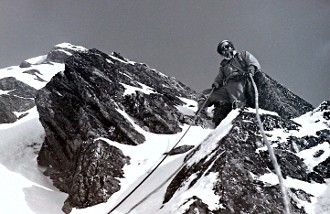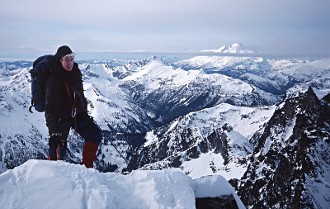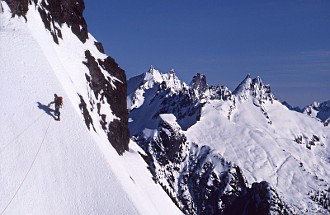
|
Summits of Isolation - Winter Climbing in the North Cascade RangeWhen Captain George Vancouver sailed up the Strait of Juan de Fuca in 1792, the first Cascade peak he saw was Mount Baker. Since that day, Mount Baker has been the magnet of the North Cascades. On a clear day, the peak is visible from Vancouver, British Columbia, to Tacoma, Washington. In August 1868, Edmund Coleman, an English alpinist living in Victoria, made the first ascent of Mount Baker along with three companions. Other climbs followed, but nearly 60 years passed before the mountain was climbed in winter. The Mount Baker Club was formed in 1911 to promote the Mount Baker area as a national park. It lobbied Congress for a national park in 1916, but World War I diverted attention and the idea died. The club also popularized summit climbs by staging the grueling Mount Baker marathons from 1911 to 1913. Competitors would race from Bellingham to Mount Baker by car or train, then run to the summit and back, returning to Bellingham in as little as nine and a half hours round trip.
In the summer of 1925, the club constructed a cabin near timberline on the northwest side of Mount Baker. Kulshan Cabin was ten miles by trail above the town of Glacier. The cabin provided shelter from the elements during climbs of the mountain, making winter mountaineering practical. Mount Baker Club members took advantage of the cabin immediately. In December 1925, W.L. Cochran, Clarence (Happy) Fisher, Louis Gilfilen, and Jerry Smith used the cabin to make the first winter climb of the mountain via the Coleman Glacier route. At that time, Mount Baker was unique in the North Cascades both for its prominence and its reasonable access, thanks to Kulshan Cabin. As the development of skiing brought winter road-access to Heather Meadows in the 1930s, Mount Shuksan also became more accessible. The first ski ascent of Shuksan’s White Salmon Glacier was made from the Mount Baker ski area by Dr. Otto Trott and Hank Reasoner in March 1941. Their ascent was just outside the true winter season, but possessed the qualities of a classic winter climb: a ski approach, a high bivouac, and a climb of the ice-covered summit on crampons. The 1930s were a Golden Age of summer mountaineering in the North Cascades, when peaks such as Challenger, Fury, Eldorado, Dome, Goode, and Bonanza were first climbed. But winter was a different story. Besides Mount Shuksan, no significant new winter ascents were recorded in the North Cascades during the 1930s and 1940s. Winter exploration was generally limited to the South Cascades and to Stevens and Snoqualmie Passes. The North Cascades were simply too inaccessible. Following World War II, mountaineers returning to the Cascades benefitted from equipment and techniques developed for U.S. Army mountain troops during the war. One of the few climbers with a taste for winter mountaineering was Pete Schoening. Between 1947 and 1951, Schoening made several attempts to climb Mount Olympus (in the Olympic Mountains) in winter. He completed the first winter ascent of a technical rock climb in the Cascades on the South Face of The Tooth in 1952. In the North Cascades, he climbed Whitehorse Mountain in the winter of 1953. Six months later, he made the most famous belay in mountaineering history, saving six companions after a fall high on K2.
Few winter ascents were recorded in the North Cascades during the 1950s. The most noteworthy climbs were made by Canadians near the Canadian border. Fips Broda and John Dudra climbed Mount Slesse in 1955. Henryk Mather and Elfrieda Pigou climbed the east buttress of Mount Larrabee three years later. Winter mountaineering grew slowly in the 1960s, with much of the activity taking place between Stevens Pass and Glacier Peak, a bit south of the North Cascade core. The winter of 1962-63 was the driest in the Cascades in more than 30 years. Developers of the newly opened Crystal Mountain Ski Area fretted about snow conditions, but a small number of mountaineers simply hung up their skis and went climbing. Fred Beckey made three new winter climbs that year, including Three Fingers and Sloan Peak. Dan Davis climbed Mount Baring, and along with Pat Callis, completed the finest winter climb in the range to that date on the North Peak of Mount Index. Beckey and Davis were the most active winter pioneers during the 1960s, but the plum of North Cascades winter ascents was picked by Alex Bertulis, Bill Sumner, and Pete Williamson. In March 1968 they climbed the iconic West Ridge of Forbidden Peak in what would soon become the new North Cascades National Park. In September 1972, the long-awaited North Cascades Highway opened to the public. The dream of a road across the North Cascades dated from the gold-rush days of the 1890s. While the highway had an immediate impact on summer access, it had minimal effect on winter mountaineering, since the road was generally closed between November and April. The first winter climb of Liberty Bell, the dominant peak above Washington Pass, was completed by Fred Dunham and Gene Prater in March 1972, just months before the highway was finished.
The mid-1970s brought a series of drought winters, with meager snow conditions at the Cascade ski areas. This combined with the growing popularity of mountaineering produced an unprecedented number of new winter climbs. During the winters of 1975 and 1976, most of the activity took place in the Stuart Range of the Central Cascades. Noteworthy exceptions were the climbs of Mount Shuksan’s North Face by Dave Seman, Reed Tindall, and friends around New Year’s Day 1976. The winter of 1976-77 was unique. Due to a severe snow drought, the North Cascades Highway remained open all winter, the only time this has occurred in the road’s history. Joan Firey wrote in the 1978 Mountaineer, “The drought winter of 1976-1977 presented climbing conditions that had not been experienced in recent history and may not be seen again in the present generation. [...] Many winter ascents were done in usually inaccessible regions because of relatively easy access.” Joan Firey led the first winter ascent of Mount Terror in the Picket Range that February. Dave Tucker’s party climbed both Mount Challenger and Whatcom Peak around the same time. Together with the 1976 ascent of West McMillan Spire by Mike Colpitts and Jaerl Secher-Jensen, these winter climbs were breakthroughs in the forbidding Picket Range. While the North Cascades Highway stayed open in 1976-77, climbers bagged Cutthroat Peak and Whistler Mountain, two of the most accessible peaks near the road. But the most remarkable ascent was on Liberty Bell Mountain near Washington Pass. Over a period of five days, Jamie and Matt Christensen, Dale Farnham, and John Znamierowski climbed Liberty Crack, the classic “big wall” of the North Cascades. Their ascent was completed mostly by aid climbing in snow- and ice-choked cracks.
Winter climbing in the North Cascades came of age in the 1980s. In previous decades, most winter exploration had taken place in other parts of the Cascades. But in the 1980s, the North Cascades became the center of activity for the first time. Summer testpieces were tackled in winter. Climbers began trying routes that were only feasible when covered with snow and ice. The emerging attitude was expressed by Doug Klewin and Dan McNerthney in the 1981 American Alpine Journal when they wrote: “We agree with many locals that the ‘real climbing’ on many Cascade Peaks is during the cold, dry spells of winter.” The light winter of 1980-81 yielded climbs of many North Cascade giants, including Jack Mountain, Mt. Formidable, Shuksan’s Price Glacier, Johannesburg Mountain, Eldorado Peak, Mt. Torment, and East McMillan Spire. These climbs were of moderate difficulty, but they showed that more and more climbers were willing and able to tackle the North Cascades in winter. As the 1980s progressed, the list of winter ascents grew to include Mt. Logan, Tomyhoi, Isolation Peak, Mt. Triumph, Mt. Despair, Hozomeen Mountain (North Peak), White Chuck Mountain, Black Peak, and Luna Peak.
Building on this base of exploration, a handful of alpine climbs set new standards of difficulty in winter. Three outstanding climbs were made by Jim Nelson, Kit Lewis, and friends. In 1983 they climbed Nooksack Tower, the legendary “Devil” first ascended by Fred Beckey and Cliff Schmidtke in the summer of 1946. The following year they climbed Burgundy Spire in frigid temperatures, carefully brushing snow off rock holds and spending three nights on the spire. Finally, in 1986, after six attempts foiled by weather, they climbed the classic Northeast Buttress of Mount Slesse. Nelson and Lewis spent a week on this snow- and ice-covered rock climb, including three nights tent-bound in storm a few pitches below the summit. In 1988, Kit Lewis completed another big winter route with Bill Liddell, the West Ridge of Eldorado Peak. For its size, remoteness and difficulty, one of the finest winter climbs yet done in the North Cascades is the Northeast Buttress of Mount Goode, completed in 1984 by Bill Pilling and Steve Mascioli. The trip required ten days; three days were needed just to ski from the Stehekin River road to the base of the mountain. Two nights were spent on the technical part of the climb. Pilling and Mascioli also climbed the 5000-foot Northeast Rib of Johannesburg Mountain that winter, one of four separate winter routes done on Johannesburg during the 1980s. Prior to the 1980s, winter ascents in the North Cascades were always on routes that had been pioneered in summer. Now climbers began attempting routes in winter (or early spring) that were attractive only when plastered with snow and ice. Along the North Cascades Highway, they included the North Face of Graybeard (1983), the East Face Couloir of Cutthroat Peak (1984), the North Face of Colonial (1986), and the North Face of Pyramid Peak (1987). On Mount Slesse, Canadian climbers established imposing routes to the right of the Northeast Buttress — the North Couloir (1980) and Arctic Wing (1989). Canadians also climbed many winter routes in the Cheam Range, the northern limit of the Cascades above the Fraser River Valley. After the unprecedented decade of the 1980s, there was a significant pause. Canadian climbers continued to explore routes north of the U.S. border in the 1990s, but at a slower pace than before. In the North Cascades of Washington, only a handful of new winter climbs were made during this period. Most remarkable was the ascent of Dome Peak in 1994. Spearheading this climb was Fred Beckey, age 71, who by this time had been climbing hard in the Cascades in both summer and winter for over 50 years.
Exploratory climbing in the Cascades, both in summer and winter, rebounded in the new millennium thanks to a new generation of climbers and a new wave of energy in the climbing community. Contributing to this surge was the revolution in digital media. News of climbs and conditions that would have spread slowly through the local community a few years earlier now propagated around the world in minutes via the Internet. Colin Haley, with various partners, completed long-sought-after winter ascents throughout the range, including the full North Ridge of Mount Stuart near Leavenworth with Mark Bunker. In the North Cascades, he made the first winter climbs of Inspiration Peak (2003), The Chopping Block (2004), and the Northeast Ridge of Mount Triumph (2005). Climbing alone, Roger Jung made the first winter ascent of Mount Fury in February 2004, a bold venture to the very heart of the Picket Range. Tragically, Jung disappeared during a solo outing in the Entiat Mountains a year and a half later. In autumn 2004, John Scurlock began posting images taken from his airplane on the Internet. Suddenly, winter scenes known by few — or never seen before — could be studied at leisure. By coincidence, the drought winter of 2004-05 presented climbing conditions not seen in the Northwest since 1976-77. Word of Scurlock’s stunning photographs spread rapidly through the climbing community and soon climbers were setting out for new winter ascents, taking advantage of both excellent conditions and fresh inspiration. Scurlock’s images directly inspired several climbs, including the Northwest Face of Chiwawa Mountain (Colin Haley and Dave Burdick), the Northeast Couloir of White Chuck Mountain (Darin Berdinka, Gene Pires, and Justin Thibault), and the East Face of Whitehorse Mountain (Pete Hirst and Rolf Larson). As a result, 2004-05 was the most prolific winter climbing season in Cascade history. Today, winter climbing in the North Cascades has taken on a life of its own. A sure sign of this occurred in March 2010, when Tom Sjolseth and Daniel Jeffrey made the first winter ascent of Assassin Spire, an airy satellite of Lincoln Peak near Mount Baker. Due to fearsomely bad rock, the spire had never been climbed — and may never be climbed — in summer. But when coated with ice and snow, it became feasible. The climb of Assassin Spire was the first time in North Cascade history that a noteworthy peak was climbed in winter before it was ever climbed in summer.
This essay was written for the book, Snow & Spire: Flights to Winter in the North Cascade Range, by John Scurlock, released by Wolverine Publishing in 2011. On October 25, 2012, the essay was updated to better describe climbing in the 1990s. |
The Alpenglow Gallery





